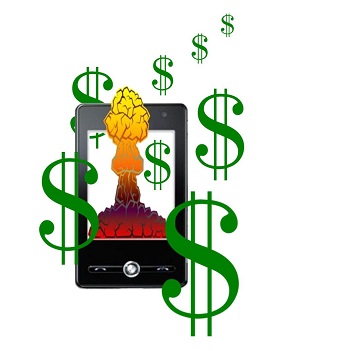The massive online marketplace has informed buyers in the country that they won’t accept smartphone returns.
Amazon India has now released a statement to shoppers in India to let them know that if they buy mobile phones over the online marketplace and that is not an order fulfilled by the company, itself, then the devices are not returnable.
Feature and smartphones purchased in orders fulfilled by Amazon, itself, will still be covered by the return policy.
When orders are not filled by Amazon, buyers will only be able to have the product replaced in the case that it arrived in defective or damaged condition during transit. That said, the “no longer needed” option will not be available on those purchases any longer. The option for replacement of the product will be available to buyers for a span of 10 days after it was delivered.
The new regulation regarding the withdrawal of the return of mobile phones became effective on February 7.
 It was becoming quite well known that the return policy was being abused in India when it came to mobile devices. This was becoming a regular issue from which both Amazon India and the website’s massive seller community, were suffering. It was reaching the point that it was commonplace for buyers to purchase the latest mobile technology, use it for a few days and then return it.
It was becoming quite well known that the return policy was being abused in India when it came to mobile devices. This was becoming a regular issue from which both Amazon India and the website’s massive seller community, were suffering. It was reaching the point that it was commonplace for buyers to purchase the latest mobile technology, use it for a few days and then return it.
The returns were being made regardless of the fact that there was nothing wrong with the device. This was causing Amazon India to have to take on the cost of the additional shipping of the perfectly functional smartphones. At the same time, the sellers of the mobile devices were finding themselves having to return the purchase price and deal with the returned merchandise.
The situation for sellers through Amazon India is not the same as that in the United States. In the U.S., a restocking fee is sometimes charged to the buyer when an item is returned for reasons other than damage or defectiveness. Without these additional levels of deterrent, the system was being abused, particularly in the case of the purchase of mobile phones.
TrendForce predicts surge of the global mobile payments market through 2019
The global mobile payments market is expected to surge this year. TrendForce, an analyst firm based in Taiwan, has released a new report that predicts the strong growth that the market will experience, with growth expected to pick up momentum through 2019. According to the report, the number of mobile payments being made is expected to reach $620 billion by the end of this year, up from the $450 billion that was recorded in 2015.
Companies look to find a place in China’s mobile commerce market
TrendForce believes that Apple Pay, Samsung Pay, and similar services from large companies will become more popular throughout the world. The growth of the mobile payments market is expected to be secured in China, where companies are fighting for the favor of those interested in mobile commerce. China is considered the world’s largest and fastest growing mobile payments market, with several companies specializing in digital commerce having found major success by engaging the growing number of mobile consumers.
Alibaba and Tencent ensure that consumers are involved in the mobile commerce space
 Massive companies like Alibaba and Tencent have established a powerful foothold in the mobile payments market. These companies have ensured that it will be difficult for other companies to compete in China. These companies have also succeeded in making mobile payments more secure, which has created a great deal of confidence among consumers and ensuring that they will participate in the mobile commerce space.
Massive companies like Alibaba and Tencent have established a powerful foothold in the mobile payments market. These companies have ensured that it will be difficult for other companies to compete in China. These companies have also succeeded in making mobile payments more secure, which has created a great deal of confidence among consumers and ensuring that they will participate in the mobile commerce space.
Biometric technology will make the mobile payments space more secure
According to the report from TrendForce, the global mobile payments market will hit $930 billion by 2018 and $1.08 trillion by the end of 2019. By that time, mobile transactions are likely to be protected by biometric technology. TrendForce expects that more than 40% of smartphones throughout the world will be equipped with fingerprint scanners, which will be used to protect consumer information when they are making a mobile transaction. This degree of security is likely to encourage more consumers to make mobile payments in the coming years.
 It was becoming quite well known that the return policy was being abused in India when it came to mobile devices. This was becoming a regular issue from which both Amazon India and the website’s massive seller community, were suffering. It was reaching the point that it was commonplace for buyers to purchase the latest mobile technology, use it for a few days and then return it.
It was becoming quite well known that the return policy was being abused in India when it came to mobile devices. This was becoming a regular issue from which both Amazon India and the website’s massive seller community, were suffering. It was reaching the point that it was commonplace for buyers to purchase the latest mobile technology, use it for a few days and then return it.
 Massive companies like Alibaba and Tencent have established a powerful foothold in the mobile payments market. These companies have ensured that it will be difficult for other companies to compete in China. These companies have also succeeded in making mobile payments more secure, which has created a great deal of confidence among consumers and ensuring that they will participate in the mobile commerce space.
Massive companies like Alibaba and Tencent have established a powerful foothold in the mobile payments market. These companies have ensured that it will be difficult for other companies to compete in China. These companies have also succeeded in making mobile payments more secure, which has created a great deal of confidence among consumers and ensuring that they will participate in the mobile commerce space.